Biodiversity
- Daifuku Group Action Guidelines for Biodiversity
- Disclosures based on TNFD Recommendations
- Major Initiatives
- Participation in nature-related initiatives
Daifuku Group Action Guidelines for Biodiversity
Basic Approach
The Daifuku Group recognizes that biodiversity conservation is an important theme to be addressed in order to create a sustainable society. Under the Daifuku Group Environmental Policy and the Daifuku Environmental Vision 2050, we aim to achieve zero negative impacts on natural capital by implementing specific annual plans based on a medium- to long-term perspective.
Action Guidelines
- Understanding
-
- Through systematic training and awareness-raising, all Group executives and employees will gain a better understanding of the sustainable use of ecosystem services and the importance of biodiversity conservation.
- By referring to international guidelines, we will work to understand and evaluate the impact on biodiversity of all of our business activities, from the procurement of raw materials to the disposal of products.
- Acting
-
- We will comply with laws, regulations, and international rules related to biodiversity conservation, and we will collaborate and cooperate with a diverse range of stakeholders, including governments, NPOs and NGOs, local residents, business partners, and employees.
- We will minimize negative impacts on biodiversity by reducing CO2 emissions in manufacturing, promoting resource recycling, and reducing hazardous substances.
- We will consider the ecosystems of the surrounding area in our use of land, and we will implement initiatives at each of our sites that will lead to the conservation of biodiversity.
- Disclosing
-
- We will make efforts to communicate with stakeholders by actively disclosing information on natural capital as well as information on our biodiversity conservation efforts.
Established: August 31, 2023
Disclosures based on TNFD Recommendations
Daifuku joined the TNFD* Forum in February 2025, and we have since been disclosing information in accordance with the core elements of the TNFD recommendations on nature-related financial disclosures, including governance, strategy, risk and impact management, and metrics and targets.
- *Taskforce on Nature-related Financial Disclosures
General Requirements
- The application of materiality:
- Together with TCFD disclosures, we disclose the financial impact of nature (single materiality) on our company.
- The scope of disclosures:
- Please refer to the section “1. Setting the scope (scoping)” under Strategy.
- Location of nature-related issues:
- Please refer to the section “2. Identification of priority locations (locate)” under Strategy.
- Integration with other sustainability-related disclosures:
- Our disclosures are consistent with climate change (TCFD) and other sustainability-related disclosures.
- The time horizons considered:
- Please refer to the section “4. Assess risks and opportunities (assess)” under Strategy.
- The engagement of indigenous peoples, local communities, and affected stakeholders:
- Please refer to the section “Supervision of stakeholder engagement” under Governance.
Governance
The supervision and execution system for nature-related risks and opportunities is the same governance system as that for climate-related risks and opportunities. For details, please refer to the Disclosures Based on TCFD Recommendations section on the following webpage.
Monitoring and incentives for nature-related targets
Plans and targets for nature-related issues are managed within the framework of the four-year business plan, and progress is managed by the Sustainability Management Committee and monitored by the Board of Directors.
Nature-related agenda items at the Board of Directors and other meetings (FY2024)
| Board of Directors |
|---|
|
| Sustainability Promotion Committee (held twice) |
|
Supervision of stakeholder engagement
The Daifuku Group has business locations all over the world, and it is essential to build good relationships with the local communities in order to conduct our business smoothly. To that end, we strive to engage in active communication with stakeholders by understanding the diverse cultures and laws and regulations of each country and region as well as through social contribution activities and collaboration with various organizations.
The Daifuku Group supports international standards such as the United Nations Guiding Principles on Business and Human Rights and the UN Global Compact. In the Daifuku Group Human Rights Policy, established in 2021, we recognize stakeholders whose human rights are or may be affected, and we commit to engaging in appropriate dialogue and consultation regarding actual or potential negative impacts on human rights. Furthermore, we have formulated the Daifuku Group Procurement Policy and Sustainable Procurement Guidelines and are disseminating them throughout our entire supply chain in order to ensure that our procurement activities do not have any negative impacts on the health and living environments of the people in the regions where we operate.
The planning and progress of initiatives related to sustainability, including respect for human rights, is managed by the Sustainability Promotion Committee and is ultimately overseen by the Board of Directors through reports from the Sustainability Management Committee.
Please refer to the webpages below for details.
Strategy
To clarify the relationship between our business activities and ecosystems, the Daifuku Group has mapped the interactions between our product processes, land use, and other aspects with ecosystems, and we have been conducting activities that take biodiversity into consideration. In disclosing information based on TNFD recommendations, we identified and assessed nature-related risks and opportunities based on the relationship map between Daifuku and biodiversity and in line with the LEAP approach* presented by the TNFD.
- *LEAP approach: an integrated assessment process for the management of nature-related risks and opportunities (an acronym for locate, evaluate, assess, prepare)
Please enlarge the screen to view
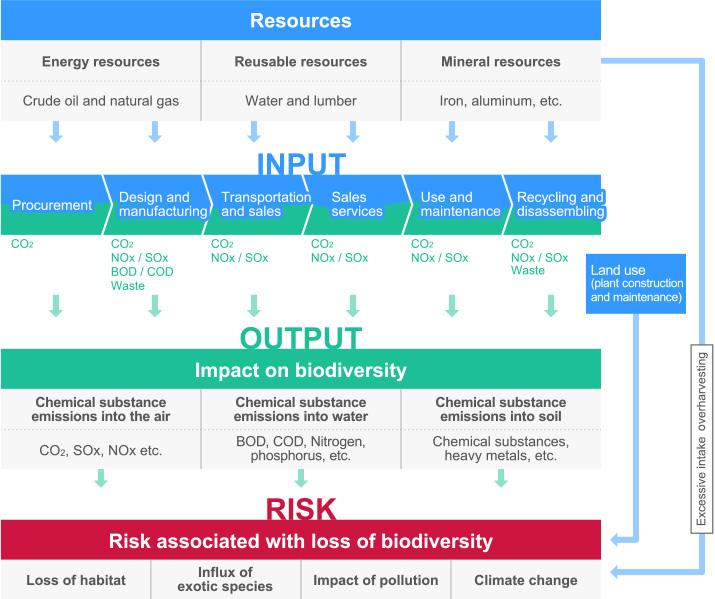
1. Setting the scope (scoping)
After organizing the value chain of Daifuku’s business, we set the scope to encompass Daifuku Japan and our domestic Group companies. We determined the scope of our upstream value chain by selecting major suppliers and raw materials based on their importance to our business and their dependence and impacts on nature. With regard to major raw materials, we selected iron, aluminum, and copper, taking into consideration high-impact commodities,* regulations on minerals, and minerals subject to responsible sourcing initiatives.
- *High-impact commodities: goods or products whose production is identified by SBTs for Nature as having a significant negative impact on nature
Please enlarge the screen to view

2. Identification of priority locations (locate)
Method for identification of priority locations
We identified priority locations based on their business importance (the relationship between our business and nature) and their natural importance (areas considered to be ecologically sensitive or significant).
From the perspective of business importance, we analyzed our domestic Group companies and major suppliers identified during scoping. We then focused on production sites involved in our core business activities (manufacturing), which have relatively high dependencies and impacts on nature. In addition, the mining and processing locations of raw materials (iron, aluminum, copper) were determined by estimating the major mining countries and mines as well as processing countries, based on global reserves and Japan’s trade situation.
To understand the importance of these production bases and raw material mining and processing areas from a natural perspective, we conducted an assessment using the WWF Biodiversity Risk Filter,*1 the Global Forest Watch map,*2 and case studies. The assessment was based on the criteria proposed by TNFD: decline in ecosystem integrity, biodiversity importance, ecosystem integrity, water stress, and importance of ecosystem service provision.
- *1WWF Risk Filter: a tool for assessing a company’s biodiversity and water risks
- *2Global Forest Watch map: a tool that provides maps of deforestation, land use, etc.
Results of identifying priority locations
As a result of the assessment, Daifuku Shiga Works and Daifuku Manufacturing Technology Headquarters were identified from among the Group’s domestic production sites as priority locations due to their high water risk (flooding, water quality), as shown in the table below. The locations of both sites are shown in the figure below.
In addition, suppliers’ production sites and the mining and processing sites of raw materials (iron, aluminum, and copper) were also identified as priority locations because of their high importance in terms of one or more of the criteria listed above. Raw materials are presumed to be extracted and/or processed in Chile, Peru, Brazil, Mexico, South Africa, the Democratic Republic of Congo, Guinea, the United Arab Emirates, Nigeria, Qatar, China, South Korea, Taiwan, Thailand, India, Indonesia, Malaysia, Australia, New Zealand, the United States, Canada, Sweden, Austria, and Germany.
| Site name | Decline in ecosystem integrity |
Biodiversity importance |
Ecosystem integrity |
Water risks (scarcity/flooding/quality) |
Importance of ecosystem service provision |
|---|---|---|---|---|---|
| Daifuku Shiga Works | Medium | Medium | Low | High (flooding, water quality) |
Low |
| Daifuku Manufacturing Technology Headquarters |
Medium | Medium | Low | High (flooding, water quality) |
Low |
| Contec Komaki Works | Medium | Medium | Medium | Medium | Low |
- *Evaluated on a five-point scale: very high, high, medium, low, very low
Please enlarge the screen to view
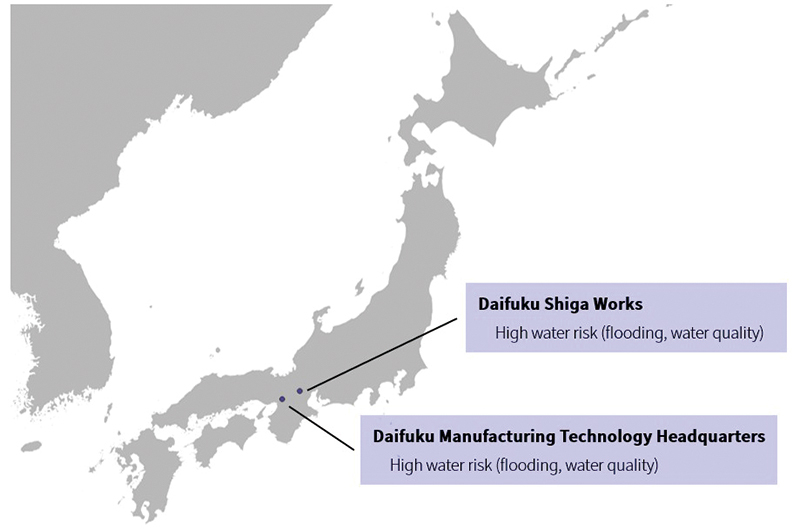
3. Evaluate dependencies and impacts (evaluate)
We used ENCORE* to evaluate the dependence and impact on nature at each process stage in our business’ value chain and organized the results into a heat map. As a result, we found that there is dependence and impact on nature in each process stage of the value chain, and that there is a particularly large dependence and impact on the mining of raw materials (iron, aluminum, copper). The details are as follows.
- Dependencies
-
- Water-related functions (water supply, water purification, water flow adjustment)
- Prevention of natural disasters (flood and storm damage mitigation from plant life (e.g., windbreak forests, etc.))
- Climate regulation functions (rainfall and global temperature regulation from plant life)
- Impacts
-
- Development in freshwater and marine areas
- Abiotic resource extraction (minerals)
- Greenhouse gas emissions
- Air, soil, and water pollution
- Generation of waste (slag)
- Noise and other disturbances
Although the manufacturing, relocation, inspection, and repair work of the Group does not rely heavily on nature, the impact of soil and water pollution caused by harmful substances generated in the manufacturing process is increasing.
- *ENCORE: a tool to understand how business activities depend on and affect nature
Heat map of dependencies on nature
Please enlarge the screen to view
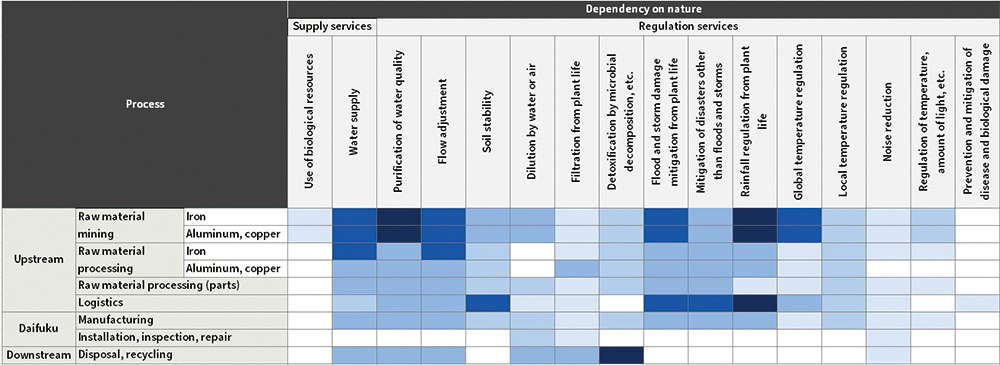

Heat map of impacts on nature
Please enlarge the screen to view
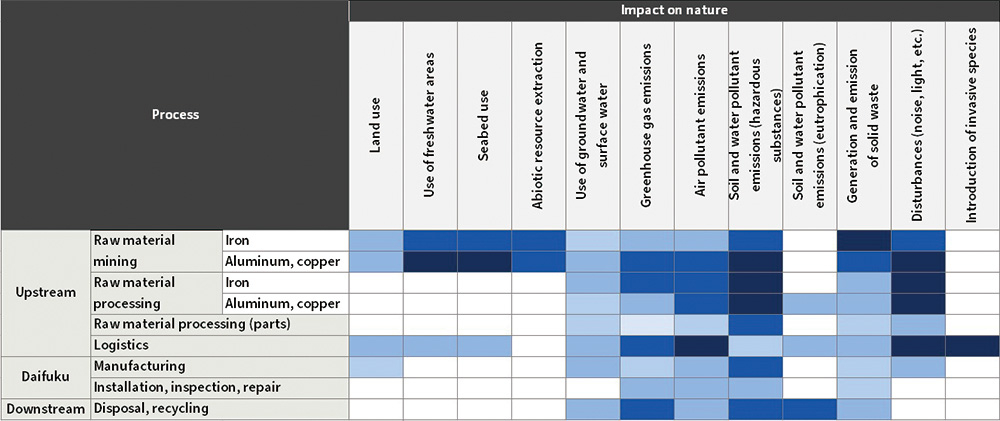

4. Assess risks and opportunities (assess)
We organized the content that was evaluated as having a large degree of dependency and impact as “natural factor drivers,” and from there we identified the nature-related risks and opportunities that the Daifuku Group could anticipate facing in the future. Based on the results of identifying priority locations, we qualitatively and quantitatively assessed the potential impacts of nature-related risks and opportunities on the Group’s business. These were then organized along three dimensions: the time period until risk manifestation or opportunity realization, the likelihood of occurrence, and the potential financial impact. We will implement appropriate responses to each risk and opportunity. The definitions of time period, likelihood, and impact are as shown below.
| Time period | Short term: less than 3 years; medium term: 3 to 10 years; long term: more than 10 years |
|---|---|
| Likelihood | Low: somewhat uncertain; medium: intermediate; high: somewhat certain |
| Impact |
|
Risks and opportunities for Daifuku Japan and our domestic Group companies
| Category | Natural factor drivers | Major risks and opportunities | Time period | Likelihood | Impact | Main responses to risks and opportunities | |
|---|---|---|---|---|---|---|---|
| Transition risks | Policy regulations | Mining and processing of raw materials Strengthening regulations on seabed use; mineral resource extraction; air, water and soil pollution; waste; noise; etc. |
Increased procurement costs due to tighter nature-related regulations |
Medium- to long-term | Small | Medium | ① Reduction of environmental impact in the supply chain |
| Reputation | Mining and processing of raw materials Negative impact on seabed use; mineral resource extraction; air, water and soil pollution; waste; noise; etc. |
Deterioration of reputation due to the negative impacts from extracting and processing mineral resources |
Medium- to long-term | Medium | Small | ||
| Policy regulations | Internal production Stricter regulations on air, water, and soil pollution |
Increased operating costs due to tighter nature-related regulations |
Medium- to long-term | Small | Small | ② Strengthening environmental pollution prevention | |
| Policy regulations Market |
Internal production, product use Regulations concerning the reduction of environmental impact; growing market demand for reducing environmental impact |
Decrease in sales due to delay in development and design of products with less environmental impact |
Medium- to long-term | Small | Small |
③ Balancing environmental and social value in material handling systems ④ Compliance with regulations related to hazardous substances |
|
| Physical risks | Acute and chronic | Mining and processing of raw materials Increase and intensification of water shortages (drought) and flood and storm damage |
Increase in raw material procurement costs due to water shortages and flood and storm damage |
Medium- to long-term | Small | Medium | ① Reduction of environmental impact in the supply chain |
| Opportunities | Resource efficiency Market |
Mining and processing of raw materials Decline in mineral resources and transition to a recycling-based society |
Improved procurement sustainability by reduction of virgin raw materials |
Long-term | Medium | Small | ⑤ Product design for resource conservation |
| Resource efficiency | Direct operations manufacturing Improved resource efficiency (reduction of water consumption, waste generation, energy consumption, etc.) |
Reduction of operating costs through resource efficiency | Long-term | High | Medium | ⑥ Reduction of water consumption, waste generation, energy consumption, etc. | |
| Reputation | Overall value chain Stricter evaluation of nature-related initiatives and increased requests for information disclosure |
Improved ESG evaluation and reputation through nature-related initiatives and information disclosure |
Medium- to long-term | Small | Medium |
③ Balancing environmental and social value in material handling systems ⑦ Promotion of nature conservation activities and participation in initiatives ⑧ Enhancing disclosure of nature-related information |
|
In identifying and assessing nature-related risks and opportunities, as with climate-related risks and opportunities, we assume a world based on the 1.5–2°C scenario for transition risks and opportunities and based on the 3–4°C scenario for physical risks.
5. Key actions in response to nature-related risks and opportunities (prepare)
The Group has established the Daifuku Environmental Vision 2050, and we are promoting the following measures to address identified risks and opportunities based on our policy of realizing a world where material handling systems have zero environmental impact.
① Reduction of environmental impact in the supply chain
The Sustainable Procurement Guidelines, which were established as new standards in fiscal 2023, dictate clear statements regarding the efficient use of energy and water resources as well as the reduction of pollutants and waste. To identify and mitigate risks in the supply chain, we are working to ensure that our business partners are aware of and comply with these guidelines, while also checking their compliance and conducting audits.
In addition, we have formulated the Green Procurement Guidelines that set out criteria for judging the chemical substances contained in our products, and we prioritize the procurement of products that contain fewer substances of concern. Furthermore, in 2022, the Environmental Management Subcommittee under the jurisdiction of the Sustainability Promotion Committee launched the Green Procurement Project. In this project, we are working to ensure the appropriate management of chemical substances contained in our products.
② Strengthening environmental pollution prevention
Daifuku manages specified chemical substances based on the Pollutant Release and Transfer Register (PRTR).* In the production process, paint and organic solvents are mainly used in product coating processes. Data on the amount used by each department is collated, totaled, and reported.
At Shiga Works, our flagship plant, we previously managed and treated wastewater using three wastewater treatment facilities owned by Daifuku; in fiscal 2022, we began switching to public sewage, and the transition was completed in March 2023. This decision was made after comprehensive consideration of a range of factors, including the risk of releasing abnormal wastewater if it is not properly treated, the impact on the lives and health of employees from handling chemicals, and the cost of wastewater treatment. In accordance with the change in processing methods, we comply with the water quality standards stipulated in the Sewerage Act.
- *A system designed to promote the voluntary management of chemical substances and prevent environmental pollution by requiring businesses to report to the government the amounts of potentially harmful chemicals they release into the environment (air, water, and soil) which may pose risks to human health or ecosystems.
③ Balancing environmental and social value in material handling systems
In fiscal 2024, we began sustainability performance assessments, which evaluate products and systems from both environmental and social perspectives. With regard to environmental value, we conduct Life Cycle Assessments (LCAs) for all product development, and we evaluate the environmental impact in terms of CO2 emissions, resource consumption, toxicity, energy consumption, air pollution, and water resource consumption. In addition, we are working to minimize the energy consumption from the operation of our products as well as the resources used in our products through design and the use of various technologies.
Daifuku’s products contribute to a wide range of areas including factory automation in general industry, semiconductors, and automobiles; labor-saving in distribution centers; and improving the efficiency of airport operations, thereby helping to address issues such as labor shortages, improving working environments, and enhancing productivity. By combining the material handling technology we have cultivated over the years with AI and other cutting-edge technologies, we are actively working on the development and introduction of technologies that solve new issues.
④ Compliance with regulations related to hazardous substances
The European Union’s REACH regulation (registration, evaluation, authorization, and restriction of chemicals) stipulates that chemical substances contained in products manufactured or sold in the EU must be registered with the government and assessed for safety. The RoHS Directive (restriction of the use of certain hazardous substances in electrical and electronic equipment) also restricts or prohibits the use of specified hazardous substances in electrical and electronic equipment.
The Daifuku Group closely monitors the latest trends in regulations related to these hazardous substances, and we strive to comply with laws and regulations, including those outside of Japan, through the implementation of the Green Procurement Guidelines and while collaborating with our entire supply chain. In addition, for major domestic business partners, we ask that they submit proof of receipt and written informed consent to ensure their understanding of these guidelines and to promote the proper management of chemical substances.
⑤ Product design for resource conservation
The Daifuku Group uses mineral resources (iron, aluminum, copper, etc.) and fossil-derived raw materials (resin, etc.) as the main raw materials for our products. As demand for these mineral resources and fossil-derived raw materials increases worldwide, their depletion is progressing and there is a possibility that it will become difficult to procure them in the future. On the other hand, with the transition to a recycling-based society (circular economy), it is also expected that the supply of recycled materials made from mineral resources and fossil-derived raw materials will increase and their use will progress.
In light of this, in order to improve the sustainability of the Daifuku Group’s procurement, we are promoting product designs that conserve resources, such as reducing raw materials through weight reduction and utilizing recycled plastic.
⑥ Reduction of water consumption, waste generation, energy consumption, etc.
Daifuku is promoting the reduction and recycling of waste products such as defective products and packaging materials from the manufacturing process. All Group production sites set waste weight reduction targets, and we are monitoring their achievement. In particular, we endeavor to improve the recycling rate by thoroughly sorting and collecting waste to reduce the amount of waste sent to landfills.
We are also working to reduce water consumption in our production activities and at offices. We introduced a water-saving system in fiscal 2022 at the factory building at Shiga Works that consumes the most water. As a result, in fiscal 2023 we were able to reduce annual water usage by about 45% compared to the previous year.
Please refer to the Disclosures Based on TCFD Recommendations section on the webpage below for more information about the our initiatives to reduce water and energy consumption.
⑦ Promotion of nature conservation activities and participation in initiatives
We have been carrying out biodiversity conservation activities through the Yui Project* at Shiga Works, our flagship plant, since 2014. As part of this project, we are working on initiatives such as the construction of Yui no Mori, which is home to a number of rare species, and the preservation of the wetlands that serve as the habitat of the scarlet dwarf dragonfly, which is listed in the Shiga Prefecture Red Data Book. In addition, in order to promote awareness of the importance of biodiversity preservation, we are also expanding activities to deepen our ties with the local community, such as giving lectures at educational facilities in Shiga Prefecture and collaborating with other companies to hold panel displays on dragonflies at museums.
Additionally, in order to achieve the Daifuku Environmental Vision 2050, we are participating in initiatives that aim to solve nature-related issues while also engaging in information sharing and policy advocacy. For further details, please refer to the Major Initiatives and Participation in nature-related initiatives sections.
- *Yui means “to bring together," and the project is a compilation of various activities that connect water with greenery, people with nature, and people to people.
⑧ Enhancing disclosure of nature-related information
We are continually working to improve the content of our information disclosure related to nature, focusing on our website and Integrated Report (Daifuku Report). We also hold an IR Day once a year as a forum for dialogue with institutional investors about the Group’s growth strategy and other topics, and this serves as an opportunity to provide explanations on a variety of topics including information related to sustainability.
Risk and Impact Management
The Daifuku Group's risk management system
The nature-related risk management system is the same as the climate-related system. For details, please refer to the Disclosures Based on TCFD Recommendations section on the following webpage.
Management of nature-related dependencies and impacts, risks and opportunities
Nature-related dependencies and impacts as well as risks and opportunities were assessed based on the LEAP approach presented by TNFD (please refer to the Strategy section for details). The Sustainability Management Committee, the Sustainability Promotion Committee, and the Risk Management Committee work together to develop appropriate measures and monitor high-priority nature-related dependencies, impacts, risks, and opportunities that must be addressed..
Metrics and Targets
The Group has identified promoting resource recycling and coexisting with nature as crucial issue areas in the Daifuku Environmental Vision 2050 and has set the following targets.
| Materiality | Key Performance Indicators (KPIs) |
FY2030 targets | FY2024 targets |
|---|---|---|---|
| Promoting resource recycling | Landfill disposal rate | Less than 1% | Domestic: less than 1% Outside of Japan: less than 5% |
| Reduction rate of waste emissions per unit sales*1 (compared to FY2023) |
23% | 4% | |
| Reduction rate of water consumption per unit sales*2 (compared to FY2018) |
60% | 40% | |
| Coexisting with nature | Rate of implementation of biodiversity conservation activities at major sites*3 | 100% | 10% |
| Global expansion of Sustainability Action*4 | Program expansion and awareness raising | Program expansion and awareness raising |
- *1Waste generated (tons) divided by net sales (100 million yen)
- *2Water consumption (1,000 m3) divided by net sales (100 million yen)
- *3Sites with 100 or more employees
- *4Daifuku’s unique program for sustainability awareness and training
Core global disclosure metrics
The results of the core global disclosure metrics in the TNFD recommendations are as follows. Metric numbers are based on TNFD recommendations. As for the core global disclosure metrics that have not been disclosed at present, we aim to collect data and disclose in the future.
| Metric no. | Driver of nature change | Indicator | Metric | Reporting scope | FY2024 results |
|---|---|---|---|---|---|
| ― | Climate change | GHG emissions | Scopes 1 and 2 Scope 3 |
Refer to ESG Data | |
| C1.0 | Land/freshwater/ocean use change | Total spatial footprint | Total surface area controlled by the organization | Global production sites only | 2,309,146m2 |
| C1.1 | Extent of land/freshwater/ ocean use change |
Extent of sustainably managed land/freshwater/ocean ecosystems |
Shiga Works Yui no Mori | 26,300m2 | |
| C2.0 | Pollution/pollution removal | Pollutants released to soil split by type | Substances subject to PRTR laws | Refer to Pollution Prevention and Resource Recycling | |
| C2.1 | Wastewater discharged | Amount of water discharged | Refer to ESG Data | ||
| Substances subject to PRTR laws | Refer to Pollution Prevention and Resource Recycling | ||||
| Temperature of water discharged | Global | Water temperature does not fluctuate extensively during production activities |
|||
| C2.2 | Waste generation and disposal | Total amount of hazardous and non-hazardous waste generated (by type) |
Major domestic sites only | Hazardous waste: 0t Non-hazardous waste: 0t |
|
| Weight of hazardous and non-hazardous waste disposed of |
Global production sites only | Landfill: 534.5t Simple incineration: 115.9t |
|||
| Weight of hazardous and non-hazardous waste disposed of avoiding landfills |
Global production sites only | Recycled amount: 1,839.5t Recycle rate: 93.0% |
|||
| C2.4 | Non-GHG air pollutants | Dust, SOx, and NOx substances subject to PRTR laws | Refer to Pollution Prevention and Resource Recycling | ||
| C3.0 | Resource use/replenishment | Water withdrawal and consumption from areas of water scarcity |
Water withdrawn from areas of water scarcity | Refer to Environmental Management | |
| C3.1 | Quantity of high-risk natural commodities sourced from land/ocean/ freshwater |
Amount of high-risk natural commodities (steel, aluminum) |
Refer to ESG Data | ||
| C7.2 | Description and value of significant fines/penalties received/litigation action in the year due to negative nature-related impacts |
Fines for violations of environmental laws and regulations (including water) |
Refer to ESG Data | ||
Major Initiatives
Conservation activities at Shiga Works
In terms of site area, Shiga Works is one of the largest factories in Shiga Prefecture. A survey of ecosystems within Shiga Works confirmed more than 1,000 native species as well as over 70 species of wildlife listed in the Japanese Red List (compiled and maintained by the Ministry of the Environment) and the Shiga Prefecture Red Data Book. In order to preserve this precious natural environment for future generations, we are pursuing various conservation initiatives through the Yui Project,* which promotes communication both within and outside the company.
Results of ecosystems survey (endangered species)
Listed below are the species of wildlife that inhabit or grow within the Shiga Works premises and are classified as endangered in the Japanese Red List 2020.
- Japanese Red List 2020
- Threatened - Vulnerable (VU): Species with a high risk of extinction in the wild.
Near Threatened (NT): Species that do not qualify as threatened at present but may be vulnerable to endangerment in the near future.
(as of April 2023)
| Category | Classification | Species | Number of species |
|---|---|---|---|
| Threatened - Vulnerable (VU) | Birds | Peregrine falcon | 1 |
| Amphibians | Yamato salamander | 1 | |
| Insects | Polyrhachis lamellidens (spiny ant) | 1 | |
| Plants | Golden orchid, Chinese bellflower | 2 | |
| Near Threatened (NT) | Birds | Greater white-fronted goose, crested honey buzzard, Eurasian sparrowhawk, northern goshawk | 4 |
| Reptiles | Japanese pond turtle | 1 | |
| Amphibians | Black-spotted pond frog | 1 | |
| Insects | Aeschnophlebia anisoptera (dragonfly), asiagomphus pryeri (dragonfly), trigomphus interruptus (dragonfly), trigomphus ogumai (dragonfly), xenocorixa vittipennis (water boatman), catocala actaea (moth), helochares striatus (water beetle), laccobius inopinus (water beetle), bombus ignitus (bumblebee) | 9 | |
| Plants | Agrostis valvata, yellow bladderwort | 2 | |
| Total | 22 | ||
-

Peregrine falcon
-

Chinese bellflower
-

Japanese pond turtle
-

Trigomphus ogumai
-

Golden orchid
-

Black-spotted pond frog
-

Polyrhachis lamellidens
-

Yellow bladderwort
Yui no Mori
As part of the Yui Project, we constructed Yui no Mori (yui means “bring together” and mori means “forest”), which is located within Shiga Works and comprised of conservation ponds, a learning center, and more. It is used as a place for learning within and outside the company, as well as for the biodiversity conservation of plants and animals such as a Japanese red pine forest unique to the region and the rare species of Yamato salamander.
Breeding of Yamato salamanders in conservation ponds (artificial ponds)
-
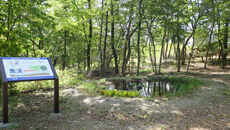
Conservation pond
-
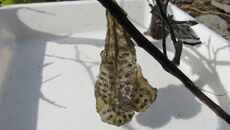
Salamander eggs in the conservation pond
-
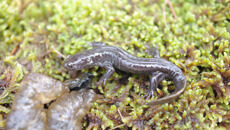
Adult Yamato salamander
We are working to preserve the endangered Yamato salamander. To ensure a stable habitat, a conservation pond was constructed in 2014, and we have been relocating the larvae and eggs that inhabit the Shiga Works premises since. We have also confirmed spawning and hatching in the conservation pond every year since fiscal 2021. In addition, there is a risk that the redevelopment of Shiga Works could lead to a reduced habitat for wild Yamato salamanders. To combat this, we are have been implementing ongoing initiatives since fiscal 2024 to maintain and improve their natural habitat, including creating a new habitat outside of the conservation pond into which larvae will be released.
Conserved Area Certification
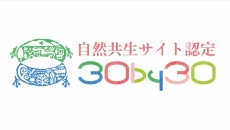
Conserved Area Certification
In September 2024, Yui no Mori was certified as a conserved area by the Ministry of Environment, Government of Japan. A conserved area refers to an area where biodiversity is being conserved through private or other initiatives; the favorable evaluations of Daifuku’s biodiversity initiatives as well as our internal and external exchange activities led to this certification.
Scarlet dwarf dragonfly habitat preservation
-
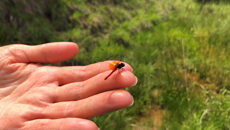
Scarlet dwarf dragonfly
-
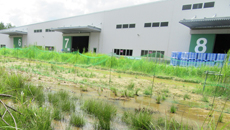
New wetlands
-
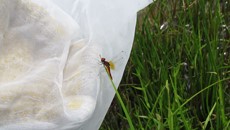
Transfer of adult insects
As part of the wetlands in which scarlet dwarf dragonflies have been confirmed to inhabit will be lost during the redevelopment of Shiga Works, we are making efforts to secure new habitats while minimizing the impact. In fiscal 2023, we created new wetlands within the Shiga Works premises, and we transferred scarlet dwarf dragonfly eggs, larvae, and adults to this new area along with hydrophytes and aquatic plants from the existing habitat. The plants that were transferred here are flourishing, and it has become an environment in which the dragonflies can settle easily. We have been conducting habitat surveys of the newly created wetlands since fiscal 2024, and we have confirmed that adult dragonflies have settled in the area.
Creating opportunities to interact with nature
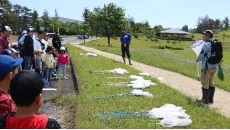
At Shiga Works, we hold nature observation events with experts so that employees have opportunities to interact with the many plants and animals that inhabit the area. We also hold events such as Christmas wreath making using natural materials procured on site.
Conservation activities at global subsidiaries
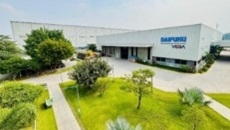
Daifuku Intralogistics India Private Limited (ILIN) has been making efforts in biodiversity conservation for over ten years through the planting of trees. By actively planting native plants that are well-suited to the local climate and soil, ILIN is contributing to the conservation of the local ecosystem while also creating a pleasant working environment surrounded by greenery.
Participation in nature-related initiatives
To achieve the Daifuku Environmental Vision 2050, the Daifuku Group is participating in initiatives that aim to solve nature-related issues, while also engaging in information sharing and policy advocacy.
Initiatives we participate in
- TNFD Forum
- 30by30 Alliance
- Keidanren Initiative for Biodiversity Conservation
- Blue Ocean Initiative (BOI)
- Shiga Biodiversity Initiatives Certification System
- The Biodiversity Biwako Network
- Members of the Osaka Bay Blue Carbon Ecosystem Alliance (MOBA)
- Declaration of Support for Osaka Biodiversity
Collaborations with local communities
Donation of Yamato salamanders to the Shiga Prefecture Lake Biwa Museum
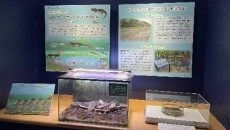
Daifuku is cooperating with local communities to take part in biodiversity conservation activities. In 2019, we donated some Yamato salamander eggs that were laid in the conservation pond in Shiga Works to the Shiga Prefecture Lake Biwa Museum. In 2025, in collaboration with an aquatic exhibit on Yamato salamander larvae at the Lake Biwa Museum, we provided the museum with some larvae that were hatched on the Shiga Works premises.
Participation in the Biodiversity Biwako Network’s dragonfly conservation efforts through corporate collaboration
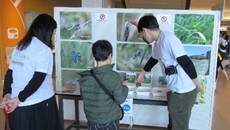
In 2016, neighboring companies* of Shiga Works launched the Biodiversity Biwako Network, which is engaged in biodiversity conservation activities using the 100 dragonfly species confirmed in the prefecture as indicators. The project, entitled Operation Dragonfly 100: Save Shiga’s Dragonflies, has three strategies: search for the 100 dragonfly species in Shiga Prefecture, protect them, and educate the public about them. We are also engaged in regular monitoring at the company site, maintenance of biotopes and extermination of invasive alien species, nature observation meetings, exhibitions and presentations of our activities, as well as understanding of the current state of nature in the surrounding area.
- *Currently, the following five companies are actively involved: Asahi Kasei Corporation; Asahi Kasei Juko Co., Ltd.; Sekisui Jushi Corporation; Daihatsu Motor Co., Ltd.; and Daifuku Co., Ltd.
Blue Ocean Initiative (BOI)
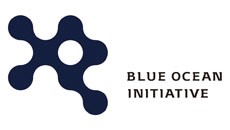
Daifuku has been a supporting member of the Blue Ocean Initiative (BOI), a blue action platform formed by a coalition of corporations, since 2023. The BOI is expanding the scope of its activities to achieve sustainable and effective ocean conservation and prosperity through multifaceted interactions and business co-creation with all stakeholders that have ties with the ocean.
Members of the Osaka Bay Blue Carbon Ecosystem Alliance (MOBA)
Daifuku has endorsed the Osaka Bay Blue Carbon Ecosystem Alliance (MOBA) of Osaka Prefecture since 2024. This Alliance endorses the creation of a blue carbon ecosystem in Osaka Bay in order to realize the Osaka Bay MOBA Link Initiative, which will connect Osaka Bay with a corridor of blue carbon ecosystems (seaweed beds and tidal flats that absorb and store CO2). The Alliance carries out its activities with the cooperation of its members, which consist of companies, organizations, research institutes, and government agencies.
Declaration of Support for Osaka Biodiversity
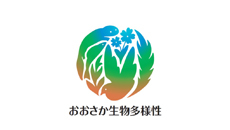
Daifuku Group company Contec Co., Ltd. endorses Osaka Prefecture’s biodiversity preservation activities. In 2023, we submitted a Declaration of Support for Osaka Biodiversity to the Osaka Prefectural Government, and its registration has been approved. This registration system enables the Osaka Prefectural Government to support the efforts of companies and organizations within the prefecture that declare their commitment to actively work toward conserving biodiversity.
